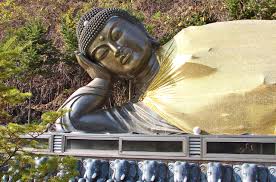According to Buddhist philosophy, the Third Noble Truth states that one can be free from suffering by attaining a state called “Nibbana”. Known in Sanskrit as “nirvana”, it means, “to extinguish”. Upon reaching nirvana, one has achieved a continued state of bliss. To arrive at nirvana, all karma must be rectified. No more bad karma remains to return to the individual in his present or future lives. Nirvana is achieved when there is no more “hatred, desire or illusion”. In essence, it has been extinguished. One no longer has to continue living or cycling through the processes of reincarnation and rebirth. Nirvana is the equivalent of enlightenment, according to some Buddhist doctrine. All Buddhists have a goal of reaching nirvana.
Finding the Path to Nirvana
Buddhists who find their own path to nirvana become “Buddhas” or “awakened ones”. They have become all-knowing. Those who become enlightened with the help of others are known as “arhats” and are not considered all-knowing. The original Buddha, Siddhartha Gautama, experienced nirvana after meditating while sitting under a tree. He viewed his past lives and discovered a “perfect knowledge” of the world just before attaining nirvana.
Celebration of Faith
 As in many other religions, Buddhism followers celebrate their faith on designated days. Nirvana Day is celebrated annually on February 15. The purpose of Nirvana Day is to celebrate the Buddha’s attainment of total Nirvana and his death. The festivities on Nirvana Day vary among Buddhist sects. Temples regard Nirvana Day as a time to socialize while some Buddhists think about loved ones who have passed on.
As in many other religions, Buddhism followers celebrate their faith on designated days. Nirvana Day is celebrated annually on February 15. The purpose of Nirvana Day is to celebrate the Buddha’s attainment of total Nirvana and his death. The festivities on Nirvana Day vary among Buddhist sects. Temples regard Nirvana Day as a time to socialize while some Buddhists think about loved ones who have passed on.
The language that clearly defines nirvana does not exist; it is so sublime that it cannot be described. Only reaching Nirvana, can one truly understand it. “Complete nirvana”, known also as “parinirvana” or “final nirvana” occurs at death. One is finally liberated from life, from feeling pain and misery. He has found the ultimate freedom.
Bibliography
Harris, T., March 30, 2004. Buddhist Nirvana (Online). Available at http://urbandharma.org/udnl2/nl033004.html . Accessed on August 13, 2007.
Harris, T., March 30, 2004. How Buddhist Nirvana Works (Online). Available at http://urbandharma.org/udnl2/nl033004.html . Accessed on August 13, 2007.
Harris, T., 2007. How Nirvana Works (Online). How Stuff Works available at http://science.howstuffworks.com/nirvana1.htm . Accessed on August 13, 2007.





